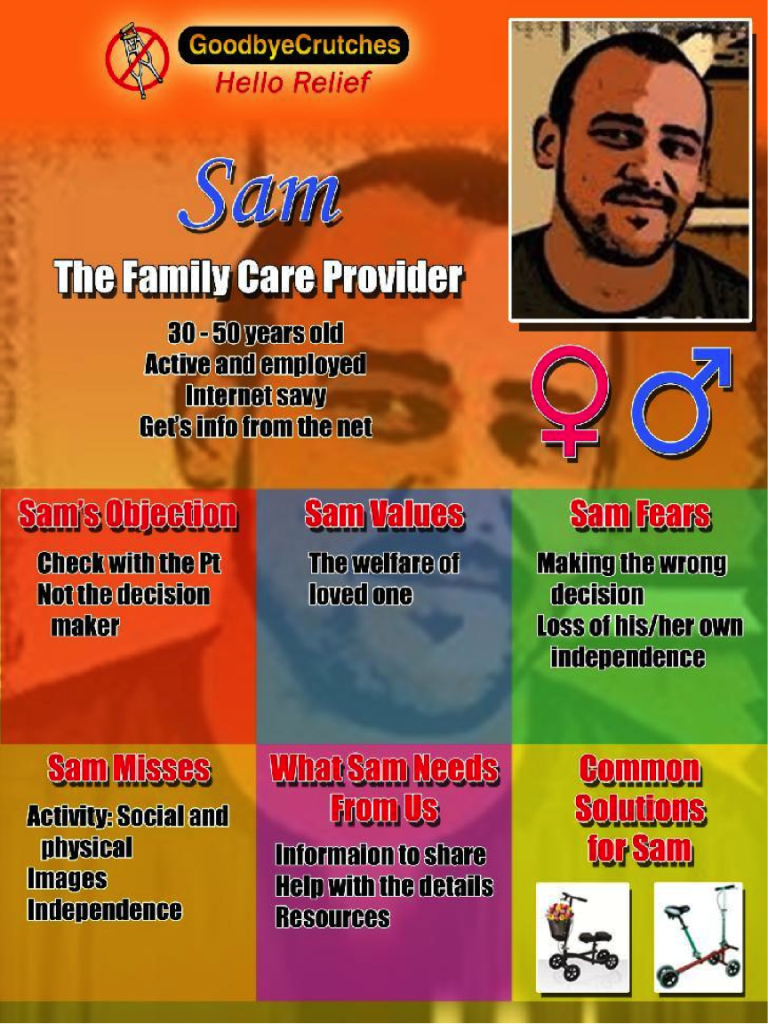There’s a scene in the movie “The Wolf of Wall Street” where Jordan Belfort, played by Leonardo DiCaprio, asks his friend to sell him a pen. In the movie, the friend answers with something about supply and demand.
The real Jordan Belfort, who the movie is based on, says the actual answer is different.
“The real answer is, before I’m even going to sell a pen to anybody, I need to know about the person, I want to know what their needs are, what kind of pens do they use, do they use a pen?”
This applies to any product. If you want people to visit your ecommerce store and buy from you, you need to know about them. You need to know their needs, goals, motivations and objections to buying your product. In short, you need to know your customer personas.
Your customer personas should look and sound like real people. http://ow.ly/AJyAS 
What is a customer persona?
Let’s clear a few things up first. A customer persona isn’t an actual person, and shouldn’t be based off of any one single customer. It’s a model that represents your customers, or a group of customers. The model may even look like and sound like a real person. If you have multiple customer segments, you can create a corresponding persona and assign fictional names to each.
Secondly, while this model might be fictional, it’s definitely not derived from fiction. The model is constructed from real and complete data about your customers. It does not contain any conjecture or information about who you want your customers to be.
Typically, apart from a name, a persona contains information about customer demographics, such as age range, gender, employment, income and location. It also captures their goals, needs or wants, challenges and objections as related to your business.
You might want to add information about your customers’ online behaviors, like the sites they visit, their social network activity, how they found your site, and what they look for when buying online.
Finally, every aspect of your customer persona should have a purpose. For example, collecting information about their eating habits is useless unless your product is somehow related to food.
The point of the buyer persona is to give you an insight into the goals, motivations and behaviors of your customers. Each aspect of the persona should contribute to that in some way.
Here’s an example from Goodbye Crutches. It’s not very detailed, but it has essential information needed for them to market their products to this customer type:

Goodbye Crutches now knows it has to focus on online marketing and concentrate on spreading useful information and resources that will ease customers’ fears. They can’t directly push products onto consumers. They need to help them first before making the sale.
Developing Your Customer Personas: Qualitative Data
Most of the data you collect for your customer personas will have to come from qualitative research. That means communicating with your customers in some way and asking them questions about their goals and needs.
There are many ways you can do this:
One-on-one
Try to get customers to sit with you in the same room or video chat with you. This way you’ll also pick up on visual cues when your customers answer your questions. If in-person interviews aren’t possible, a phone call is a good alternative.
The best thing about a one-on-one interview is that you can change it if you need to. It becomes dynamic, like a conversation. So instead of asking questions that customers have already answered, you can dig deeper and find out more.
You can also cover a lot in one sitting because talking is the fastest mode of communication. Focus on subjective and open-ended questions, like finding out what drives them, what their objections to buying are, and how you can help them.
You can send questionnaires and surveys to customers after they subscribe. While not as effective as one-on-ones, it’s more convenient. It allows customers to reply when they have some free time.
You can also survey subscribers based on their buyer journey. For example, you might want to ask subscribers who haven’t bought anything what they are looking for and what’s holding them back from buying. For customers who just bought something, you can ask them why they bought from you and how your products satisfy their needs.
The problem with email is that people tend to ignore them until later, and most often they end up forgetting. To ensure that customers answer your surveys, you can do two things.
First, give them an incentive to answer your survey. Discounts and coupons are popular choices because they help customers save, and also make them shop with you again to take advantage of the deal.
Second, try not to make the survey too long. If customers see a long list of questions, they assume it’ll take a long time to answer and they’ll ignore it. Keep it short and don’t add too many open-ended questions.
On-site
On-site surveys, when done correctly, can provide some extremely relevant insights. They are presented to customers while they are browsing your site, so the timing is perfect.
You can trigger these surveys based on the page customers are looking at, or a number of other events. You can even trigger them as customers are leaving your site and ask them whether they found what they were looking for.
Because of their nature, pop-up surveys are best suited to multiple-choice questions. There’s not much real estate to play with if you pose open-ended questions.
Again, to incentivize visitors to answer your surveys, give them an on-the-spot discount.
Try to collect as many data points as you can. Remember, a persona doesn’t represent just one customer. After a certain point, you’ll find a pattern in your qualitative data.
A Real-Life Example
When Whirlpool started creating customer personas, they found four main personas and four secondary personas. The four main personas were purchasers under duress (someone who needed a refrigerator immediately), planned remodelers, new owners and owners with repair.
When conducting their interviews, they tried to understand the mindset that each customer had when visiting their website. It was important to find out what triggered them to visit the Whirlpool site and what kind of solution they were looking for.
All this information was included when they created the personas, along with ages, names, occupations and incomes. They also added pictures of real people to help their marketing visualize the personas.
You’ll notice that Whirlpool also used website statistics to help them with their persona creation. Let’s see why this is important.
Developing Your Customer Personas: Quantitative Data
While you can create customer personas solely through qualitative research, adding some quantitative data will help you strengthen them. After all, data doesn’t lie!
Another advantage is that you can collect way more information with quantitative data than you can with qualitative. While many customers may ignore your survey requests, a good analytics solution can help you track online behaviors of every single customer.
Your analytics solution will also help you close the loop with your personas. Qualitative data helps you create the personas, but quantitative data helps you make use of them. We’ll come to that in the next section, but for now here are some metrics to track:
Demographics
Your analytics app can give you a much better view of customer demographics because of the number of data points it collects. Find out where your customers are coming from, what device or browser they use, and when they typically browse your store.
This means you don’t need to waste time asking customers where they are when you interview them. Use that time to find out the things that your analytics software can’t.
Traffic source
Your acquisition channels will help you understand why customers came to your site in the first place. Were they actively searching on Google or did they come from an ad? Did they see a review of your product online or did a friend refer them?
If they came via a search engine, you can also track the keywords they used to find you. This will give you an insight into what your customers value. Bargain hunters will use words like “cheap” while those who care about performance will use “best”.
During your qualitative research you might have noticed a pattern in the phrases and terms your customers use. Tying that in with your search engine data will show you which terms are most significant.
Customer Journey
The customer journey through your site is important too. What pages do they visit and how long do they spend on each page? How your customers navigate your site tells a story and helps you differentiate between segments.
The segment that visits your “About” and “FAQ” pages are probably very early in the buyer cycle. They want to get to know your company better and aren’t ready to buy from you just yet.
The segment visiting your blog are now considering your products and want to find more information. They are a little further along the cycle, but still not quite ready to buy.
Finally, the group spending a lot of time on your product pages is probably ready to buy. Something might be holding them back, so look through your qualitative data to find out what it is.
The flow will also tell you where customers are leaving your site. Are they dropping out at the product page or another page? This can give you insights into how your customers behave at key conversion points.
Customer Lifetime Value
You should be tracking customer lifetime value already. It’s one of your most important metrics and can help you identify which are your most profitable personas. These are the people you want to spend more time crafting offers for, as they have a higher likelihood of converting.
Putting Your Customer Personas to Work
Now that you’re created your customer personas and boosted them with quantitative data, it’s time to actually put them to some use. At the end of the day, you want to increase conversion rates and make more sales.
Here are some applications of customer personas:
Website
You can now craft a user experience on your site that speaks directly to each persona. No more generic content that makes customers feel like you don’t have the answers they’re looking for.
We’ve already seen how Whirlpool created their personas, so now it’s time to look at how they used them. Their problem was that their website was too generic, so they decided to redesign around their personas.
They created functionalities that catered to each persona. The duress purchaser needs to buy something quickly, so they implemented a filtering feature to help customers identify the best product for them in as little time as possible.
The remodeler, on the other hand, likes to take time in making a decision, so they created a showroom feature that allows customers to explore products at length. They also added a feature that allows remodelers to email products to other people involved in the remodeling.
The new redesign increased page-views by 42% and decreased bounce rates by 10%.
Product copy
When it comes to ecommerce conversion rates, product copy is one of the most important factors. It’s your sales pitch, the last thing a customer reads before clicking the “Buy Now” button.
While creating their personas, Leo Schachter Diamonds focused on the motivations and psychology behind their customers’ purchases. This helped them created targeted copy that answered questions their personas had.
This strategy helped them pre-empt any objections customers had to buying diamonds from them. Before this strategy was implemented, only 0.86% of all site visitors would go on to find a jeweler who sold Leo Diamonds. Now, because the copy solves their needs, 54% of them go on to find jewelers. That’s an increase of 5,500% in conversion rates!
Content Marketing
Now that you know your customers’ needs and requirements, you can create blog posts and other content that is relevant to them. This will attract more qualified leads with a higher chance of converting to customers.
After Skytap identified their personas, they were able to create targeted blog posts that impressed visitors. The relevancy of their content increased their organic search traffic by 55% and converted 124% more visitors into leads.
Collegis Education repurposed their content to create a targeted email campaign for subscribers. They segmented subscribers according to persona and sent them high-level content to help them solve their pain points. This resulted in an increase of 28% in open rates and 7% in conversion rates.
Advertisements
Your personas give you an idea of the language your customers use and the websites they frequent. Use this to optimize your PPC campaigns.
In Google AdWords, use the same keywords that customers use to make your ads more relevant. Your ad click-through rates will improve.
You can place your banner ads on websites that your customers visit. Again, use language that they identify with to increase your click-through rates.
Apple typically creates ads geared towards consumers, but as their products started gaining traction in businesses they wanted to include this new persona as well. In this iPad 2 ad, you can see them highlighting applications to view the stock market and make presentations.
A Tool to Understand Your Customers
If you find that consumers are not responding to your content or your offers, and that your website conversion rates are low, it means you don’t understand your customers. Use the customer persona as a tool to find out what their needs are and how you can better address them.
Have you started creating your customer personas? How many do you have?





